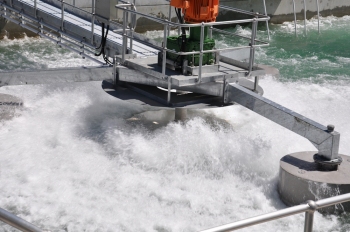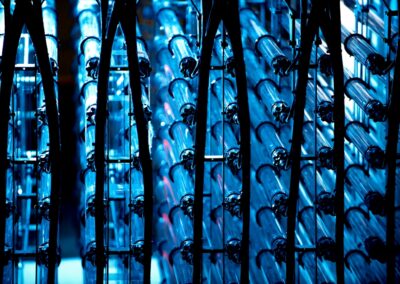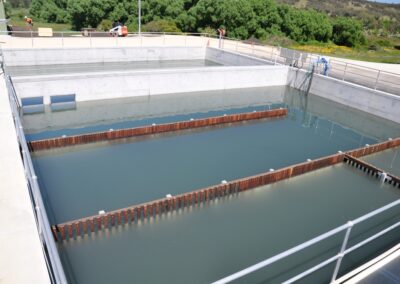- Home
- Lithgow Sewage Treatment Plant
In this section
- Air monitoring
- Council Fines
- Environment Protection License Monitoring Data
- Onsite Sewage Management Systems
- Open Burn Policy
- Pest Management Control
- Pollution
- Ranger Services
- Roadside Vegetation Conservation
- Lithgow Sewage Treatment Plant
- Tree Plans
- Underground Petroleum Storage System
- Weeds Management
Lithgow Sewage Treatment Plant
Lithgow Sewage Treatment Plant – Securing Our Water Future
Plan
There are “two” treatment plants on this site. The “original” plant is a traditional trickling filtration treatment system, which was designed and constructed throughout NSW by Public Works from about the early 1930’s until the mid 1980’s, when it was constructed here. The new plant is a modern activated sludge treatment system, known as Intermittent Decanted Extended Aeration (IDEA). This was developed by NSW Public Works in the 1960’s and 1970’s and has been provided at about 170 locations in NSW. It is a well proven and economical treatment technology. The new plant does what the old plant can’t do, that is, remove nitrogen – as well as phosphorus – the two nutrients which, in combination, are responsible for algal blooms in receiving waterways, to a very high degree.
The plant has been designed to meet the needs of Lithgow for the next 30 years. It will serve the community well and protect the receiving environment. It is a major asset of which Council and the Lithgow community can be proud.
Sewage Treatment
Inlet
As the raw sewage enters the plant, it passes through the inlet works where gross solids and grit is removed. The screens catch large objects such as sticks and rags. Next the sewage flows through a grit chamber. Here it moves slowly, so that sand, gravel and other heavy material can settle. Separation of grit from other suspended material is aided by diffused air aeration.
IDEA (Intermittent Decanted Extended Aeration) biological reactors for the further treatment of a portion of the raw sewage, and of all the effluent discharged from the trickling filter plant, receive the flow from the trickling filters. These reactors include surface aeration and treated effluent decanting systems and achieve significant (ammonia and oxidized) nitrogen removal.
At the beginning of the treatment cycle, effluent has been decanted at the end of the previous cycle. Aeration begins and continues while influent wastewater increases the volume of mixed liquor for aeration. After a period aeration stops and is followed by a non-aeration sequence in which the mixed liquor is allowed to settle and anoxic processes can occur. Following the settlement/anoxic sequence, treated effluent is discharged.
Trickling Filters
Trickling filters reduce soluble and suspended organic load of the water. They have a solid support medium on which the biomass develops in a single pass irrigation process. Treatment is carried out by the biomass which is subsequently separated from the solid support and collected as sludge.
IDEA and Nutrient Removal
The IDEA tanks are sized to accommodate a flow 7 times the average dry weather flow without appreciable loss of effluent quality. An alum storage and dosing system for phosphorus removal is included as well as pH correction. The solid matter which has been removed from the sewage is concentrated and water is removed on a belt filter press.
There are “two” treatment plants on this site. The “original” plant is a traditional trickling filtration treatment system, which was designed and constructed throughout NSW by Public Works from about the early 1930’s until the mid 1980’s, when it was constructed here. The new plant is a modern activated sludge treatment system, known as Intermittent Decanted Extended Aeration (IDEA). This was developed by NSW Public Works in the 1960’s and 1970’s and has been provided at about 170 locations in NSW. It is a well proven and economical treatment technology. The new plant does what the old plant can’t do, that is, remove nitrogen – as well as phosphorus – the two nutrients which, in combination, are responsible for algal blooms in receiving waterways, to a very high degree.
Disinfection
Finally, chlorine is added as a disinfectant where ample contact time is allowed to kill bacteria before dechlorination and the next stage of treatment through the ultra-violet disinfection chamber. It is located at the end of the plant for further bacteria reduction and the removal of Crypto-sporidium and Giardia. This provides an additional barrier to assure disinfection before discharge to the environment or use as recycled water.
Fact File
- 18 million litres of raw sewage daily maximum deÂsigned capacity
- 6 million litres of raw sewage received on average each day from Lithgow sewerage.
- 4 thousand litres of liquid trade waste received each day by tanker.
- 1 tonne of dry organic solids produced each day
- Lithgow STP is a relatively unique dual disinfection IDEA process.
- Achieves a level of treatment which satisfies best practice requirements for environmental protection
|
Biological Oxygen Demand (BOD) |
< 10 milligrams per litre |
|
Total Suspended Solids (TSS) |
< 15 milligrams per litre |
|
Total Nitrogen |
< 10 milligrams per litre |
|
Ammonia Nitrogen |
< 2 milligrams per litre |
|
Total Phosphorous |
< 0.5 milligrams per litre |
|
pH |
6.5 – 8.5 |
|
Faecal Coliforms |
< 200 organisms/100 millilitres |
- Recycled water is used throughout the plant saving drinking water and is capable of supplying signifcant quantities via an off site distribution system.
- The process has a modern electrical control and monitoring system. This allows monitoring of the operation of every treatment unit and mechanical drive at the plant and to adjust operation remotely if required. The system also raises alarms should equipment malfunction
| Phrase | Description |
|---|---|
| Activated Sludge | Aerated sewage containing microorganisms |
| Aeration | To expose to the action of air |
| Algal Bloom | An excessive growth of algae on or near the surface of water, occurring naturally or as a result of an excess of nutrients from organic pollution |
| Alum | Double aluminium sulfate used to precipitate phosphates |
| Ammonia Nitrogen | Ammonium nitrogen (NH4-N) is a primary indicator of water quality. Most of the ammonia in sewage comes from urea |
| Anoxic | Areas of water that are depleted of dissolved oxygen |
| Bacteria | Small living things (microorganisms) consisting of a single cell |
| Belt Filter Press | Sludge dewatering device that applies mechanical pressure to a chemically conditioned slurry, which is sandwiched between two porous tensioned belts, by passing those belts through a serpentine of decreasing diameter rolls |
| Biomass | The mass of living organisms in a particular environment |
| Chlorine | An element toxic to microorganisms and used for disinfection |
| Cryptosporidium | A water-borne protozoan parasite that contaminates drinking water supplies, causing intestinal infections |
| Decant | To pour off leaving sediment behind |
| Dechlorination | Removing residual chlorine |
| Effluent | Liquid waste discharged from a sewage system |
| Giardia | A single-celled protozoan, some forms of which live as parasites in the gut of humans and other vertebrates, causing an infection giardiasis |
| IDEA | Intermittent Decanted Extended Aeration |
| Influent | Something flowing in |
| Nutrients | Food substance needed for living and growing |
| Organic | Relating to, derived from, or characteristic of living things |
| Oxidised Nitrogen | The type of nitrogen (nitrite and nitrate) that is immediately available to plants in brine or freshwater |
| Reactor | A vessel or other equipment in which an industrial reaction takes place |
| Sewage | Liquid waste matter for disposal |
| Sewerage | A system of drainage by sewers |
| Sludge | Settled solids from sewage |
| Ultraviolet Light | Ultraviolet light is beyond the normal range of colours that humans can see. Too much ultraviolet light can kill microorganisms. Often referred to as UV |


